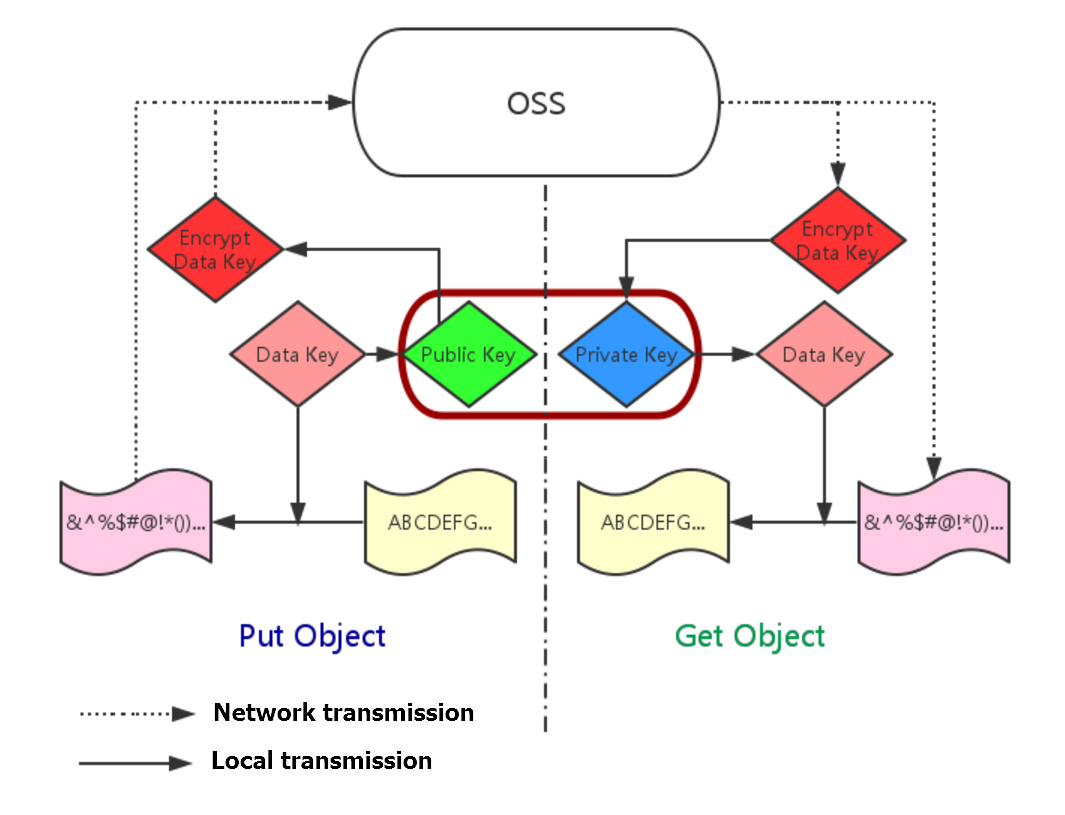クライアントの暗号化とは、ユーザーデータがリモートサーバーに送信される前に暗号化が完了し、暗号化に使用されるキーのプレーンテキストはローカルコンピューターにのみ保持されることを意味します。 そのため、たとえデータが漏洩したとしても、他人にはデータを復号化し元のデータを取得することができないため、ユーザーデータのセキュリティを確保することができます。
このドキュメントでは、現在の Python SDK バージョンの OSS に基づき、クライアント暗号化を通してデータを保護する方法を説明します。
原則
- ユーザーは、ローカルコンピュータ内で RSA キーのペア (
rsa_private_keyとrsa_public_key) を管理します。 - オブジェクトがアップロードされるたびに、AES256 タイプの対称キー
data_keyがランダムに生成されます。data_keyはencrypt_content を取得するのに元のコンテンツを暗号化するために使用されます。 rsa_public_keyを使用して、encrypt_data_keyを取得するためにdata_keyを暗号化し、ユーザーのカスタムメタとして要求ヘッダーに配置して encrypt_content と一緒に OSS に送信します。- "Get Object" が実行されると、ユーザーのカスタムメタの encrypt_content と
encrypt_data_keyがまず取得されます。 - ユーザーは
rsa_private_keyを使用して、data_keyを取得するため、encrypt_data_keyの暗号化を解除し、次にdata_keyを使用して、元のコンテンツを取得するため、encrypt_content の暗号化を解除します。
説明 このドキュメントのユーザーのキーは、非対称 RSA キーです。オブジェクトのコンテンツが暗号化される際、AES256-CTR アルゴリズムが使用されます。 詳しくは、「PyCrypto ドキュメント」をご参照ください。 このドキュメントではオブジェクトのカスタムメタを通して、クライアント暗号化を実装する方法を説明しています。 ユーザーは必要に応じて、暗号化キーの種類と暗号化アルゴリズムを選択できます。
構造のダイアグラム

準備
- Python SDK のインストールと使用法については、『Quick Installation of Python SDK』をご参照ください。
- PyCrypto ライブラリのインストール
pip install pycrypto
完全な Python コードの例
# -*- coding: utf-8 -*-
import os
import shutil
import base64
import random
import oss2
from Crypto.Cipher import PKCS1_OAEP
from Crypto.PublicKey import RSA
from Crypto.Cipher import AES
from Crypto import Random
from Crypto.Util import Counter
# aes 256, key always is 32 bytes
_AES_256_KEY_SIZE = 32
_AES_CTR_COUNTER_BITS_LEN = 8 * 16
class AESCipher:
def __init__(self, key=None, start=None):
self.key = key
self.start = start
if not self.key:
self.key = Random.new().read(_AES_256_KEY_SIZE)
if not self.start:
self.start = random.randint(1, 10)
ctr = Counter.new(_AES_CTR_COUNTER_BITS_LEN, initial_value=self.start)
self.cipher = AES.new(self.key, AES.MODE_CTR, counter=ctr)
def encrypt(self, raw):
return self.cipher.encrypt(raw)
def decrypt(self, enc):
return self.cipher.decrypt(enc)
# First, initialize the information such as AccessKeyId, AccessKeySecret, and Endpoint.
# Obtain the information through environment variables or replace the information such as "<Your AccessKeyId>" with the real AccessKeyId, and so on.
# Use Hangzhou region as an example. Endpoint can be:
# http://oss-cn-hangzhou.aliyuncs.com
# https://oss-cn-hangzhou.aliyuncs.com
# Access using the HTTP and HTTPS protocols respectively.
access_key_id = os.getenv('OSS_TEST_ACCESS_KEY_ID', '<your AccessKeyId>')
access_key_secret = os.getenv('OSS_TEST_ACCESS_KEY_SECRET', '<Your AccessKeySecret>')
bucket_name = os.getenv('OSS_TEST_BUCKET', '<Your Bucket>')
endpoint = os.getenv('OSS_TEST_ENDPOINT', '<Your Access Domain Name>')
# Make sure that all the preceding parameters have been filled in correctly.
for param in (access_key_id, access_key_secret, bucket_name, endpoint):
assert '<' not in param, 'Please set the parameter:' + param
##### 0 prepare ########
# 0.1 Generate the RSA key file and save it to the disk
rsa_private_key_obj = RSA.generate(2048)
rsa_public_key_obj = rsa_private_key_obj.publickey()
encrypt_obj = PKCS1_OAEP.new(rsa_public_key_obj)
decrypt_obj = PKCS1_OAEP.new(rsa_private_key_obj)
# save to local disk
file_out = open("private_key.pem", "w")
file_out.write(rsa_private_key_obj.exportKey())
file_out.close()
file_out = open("public_key.pem", "w")
file_out.write(rsa_public_key_obj.exportKey())
file_out.close()
# 0.2 Create the Bucket object. All the object-related interfaces can be implemented by using the Bucket object
bucket = oss2. Bucket(oss2. Auth(access_key_id, access_key_secret), endpoint, bucket_name)
obj_name = 'test-sig-1'
content = "test content"
#### 1 Put Object ####
# 1.1 Generate the one-time symmetric key encrypt_cipher used to encrypt this object, where key and start are values generated at random
encrypt_cipher = AESCipher()
# 1.2 Use the public key to encrypt the information for assisting encryption, and save it in the custom meta of the object. When Get Object is performed later, we can use the private key to perform decryption and obtain the original content according to the custom meta
headers = {}
headers['x-oss-meta-x-oss-key'] = base64.b64encode(encrypt_obj.encrypt(encrypt_cipher.key))
headers['x-oss-meta-x-oss-start'] = base64.b64encode(encrypt_obj.encrypt(str(encrypt_cipher.start)))
# 1.3. Use encrypt_cipher to encrypt the original content to obtain encrypt_content
encryt_content = encrypt_cipher.encrypt(content)
# 1.4 Upload the object
result = bucket.put_object(obj_name, encryt_content, headers)
if result.status / 100 ! = 2:
exit(1)
#### 2 Get Object ####
# 2.1 Download the encrypted object
result = bucket.get_object(obj_name)
if result.status / 100 ! = 2:
exit(1)
resp = result.resp
download_encrypt_content = resp.read()
# 2.2 Resolve from the custom meta the key and start that are previously used to encrypt this object
download_encrypt_key = base64.b64decode(resp.headers.get('x-oss-meta-x-oss-key', ''))
key = decrypt_obj.decrypt(download_encrypt_key)
download_encrypt_start = base64.b64decode(resp.headers.get('x-oss-meta-x-oss-start', ''))
start = int(decrypt_obj.decrypt(download_encrypt_start))
# 2.3 Generate the cipher used for decryption, and decrypt it to obtain the original content
decrypt_cipher = AESCipher(key, start)
download_content = decrypt_cipher.decrypt(download_encrypt_content)
if download_content ! = content:
print "Error!"
else:
print "Decrypt ok. Content is: %s" % download_content